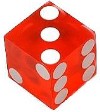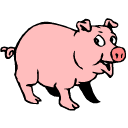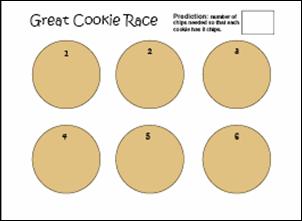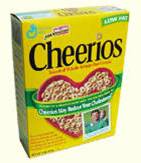
Featured Data Analysis Activity: One-Die Toss Data Collection
ONE DIE: Students need many experiences tossing one die, collecting data and analyzing that data to construct meaning for the probability of the different outcomes. Since a small student sample is often skewed, it is necessary for teachers to help students collate class data to better approximate the theoretical probability that the outcomes of tossing a single die are equally likely. See the one-die games below for motivating data collection opportunities that students will play again and again while generating larger data samples for class discussion. Many teachers find a simple class tally chart an effective way to organize data for this ongoing experiment. Students simply add results to the class results as they complete a game. Class discussions focus on the fairness of the games and discussion about whether each player has an equal chance of winning.
One-Die Games

 Game of Pig: This is best introduced as a class activity. Students collect points for each toss of the die unless a ONE is tossed, which means they lose all of the points they have collected in the round. To prevent losing their points, students may elect to stop at any point in the game before a ONE is tossed and they get to keep the points they collected but get no further points. Students love the game and begin to appreciate that theoretical probability and experimental probability are often quite different!
Game of Pig: This is best introduced as a class activity. Students collect points for each toss of the die unless a ONE is tossed, which means they lose all of the points they have collected in the round. To prevent losing their points, students may elect to stop at any point in the game before a ONE is tossed and they get to keep the points they collected but get no further points. Students love the game and begin to appreciate that theoretical probability and experimental probability are often quite different!
 Car Race: students toss a die and move cars that many spaces. First player to cross the finish line wins the game. Teachers have purchased small toy cars at the local dollar store and students love using these as game pieces. Buying several of the same collections allows teachers to package games with 3 cars of two different colors (2-player version) or 2 cars of three different colors (3-player version). PDF file includes directions, game mat and math center icons.
Car Race: students toss a die and move cars that many spaces. First player to cross the finish line wins the game. Teachers have purchased small toy cars at the local dollar store and students love using these as game pieces. Buying several of the same collections allows teachers to package games with 3 cars of two different colors (2-player version) or 2 cars of three different colors (3-player version). PDF file includes directions, game mat and math center icons.

 Ladybug, Fly Home! uses a one-die toss to move that numbered ladybug one space closer to her home. Students add their results to the Class Recording sheet by adding a tally mark for the winning ladybug. Class discussion focuses on the fairness of the game by asking if each ladybug has an equal chance to win? PDF file includes directions, game mat, recording sheet and math center icons
Ladybug, Fly Home! uses a one-die toss to move that numbered ladybug one space closer to her home. Students add their results to the Class Recording sheet by adding a tally mark for the winning ladybug. Class discussion focuses on the fairness of the game by asking if each ladybug has an equal chance to win? PDF file includes directions, game mat, recording sheet and math center icons
 Face Off!: in this one-die version, players place a counter on each number square. Player A tosses the die and removes a counter from that number on his/her side. Player B tosses the die and removes a counter from that number on his/her side. Play continues with players removing a counter, if possible, until one player removes the last counter. That player wins the game. Class data collection centers on which number counter was the last one the winner removed. PDF file includes directions, game mat, recording sheet and math center icons for Face Off!
Face Off!: in this one-die version, players place a counter on each number square. Player A tosses the die and removes a counter from that number on his/her side. Player B tosses the die and removes a counter from that number on his/her side. Play continues with players removing a counter, if possible, until one player removes the last counter. That player wins the game. Class data collection centers on which number counter was the last one the winner removed. PDF file includes directions, game mat, recording sheet and math center icons for Face Off!

 Free the Animals [one-die version]: students place six markers in any of the cages #1-6. Students may place multiple markers in some cages and leave others empty. Placing the six markers is the player's choice. Students toss one die and free an animal from that number cage, if there is one. First player to free all of his/her animals wins the game.
Free the Animals [one-die version]: students place six markers in any of the cages #1-6. Students may place multiple markers in some cages and leave others empty. Placing the six markers is the player's choice. Students toss one die and free an animal from that number cage, if there is one. First player to free all of his/her animals wins the game.
- Download the
 Free the Animals Recording Sheet: One-Die Version for student use during game playing.
Free the Animals Recording Sheet: One-Die Version for student use during game playing.

 Great Cookie Race challenges students to predict how many chips they will need to make sure each cookie has 8 chips. In this simulation, students toss a die, make a chip on that cookie and continue tossing and marking until each cookie has at least 8 chips. Students then mark their total chips on the class data chart and run another trial. Analysis questions depend on the grade level but students should be challenged to make sense of the class results. Older students should also track the number of chips in each cookie.
Great Cookie Race challenges students to predict how many chips they will need to make sure each cookie has 8 chips. In this simulation, students toss a die, make a chip on that cookie and continue tossing and marking until each cookie has at least 8 chips. Students then mark their total chips on the class data chart and run another trial. Analysis questions depend on the grade level but students should be challenged to make sense of the class results. Older students should also track the number of chips in each cookie.
NOTE: This game was developed by Kristina Kampf, a Monmouth University student, for the ED 556 Probability Fair. Cookie template and directions are included in the PDF file.
Featured Project: Cereal Toy Investigation

Cheerios Toy Investigation: This simulation introduces students to the marketing strategy of packaging toys in cereal boxes to increase sales. In this activity, one of six different toys is packed in each box of cereal on the assembly line and equal numbers of all six toys are available at all times on the shelves of grocery stores. Students are asked to estimate how many boxes of cereal the average family would have to buy to get all six different toys. Students share estimates and their reasoning and these are recorded before the simulated data collection using one die to produce the outcome of getting six different toys. This is an important step in the activity so be sure to allow adequate time for students to discuss their predictions.
- Download directions for
 Cheerios Investigation
Cheerios Investigation
- See the step-by-step lesson plan for the Cheerios Toy Investigation
Data Collection: It is best to have students work in pairs. One student tosses the die and the other student records the outcomes in a tally chart. As soon as the pair gets the last toy, they stop and total how many boxes they had to buy to get all six toys. The students add their results to the class line plot. The students then switch roles and conduct another trial. Students should conduct 2-4 trials in this manner and add their results to the class data.
Class Discussion and Analysis of Results: Assemble students where they can easily see the class results. Consider using a Think-Pair-Share strategy to give all students time to analyze the results and compare them to the predictions they made about how many boxes of cereal the average family would have to buy. Ask students how they would complete the sentences: We found out that most families would have to buy ____ boxes. I know this because ______. Lead a class discussion of the results.
Written Response: Tell students that they will write a letter to Mrs. Oats explaining the class results. They should tell Mrs. Oats whether or not they think this is a good plan that will make families buy more boxes of Cheerios. Buying the toys will cost the company lots of money so students should be sure to tell Mrs. Oats why they think the plan will work or won't work. Students may write individual letters or work as pairs to construct a letter. Students should have an opportunity to share letters with their classmates so that they learn to critique mathematical reasoning and persuasive writing skills.

Online Cheerios Investigation Simulator: the Mathwire.com Cereal Applet, designed by Erin Mulder, allows students to conduct multiple simulations and collect data on a larger sample. Students may run 20-30 trials more quickly than the dice toss. The applet is probably best used following the class data collection simulation with 6-sided dice. In this simulation, students will need to collect data on the total number of boxes bought to get all 6 toys so they must decide how best to record that data. The class must also decide on a method of recording the class data (e.g. adding to the class line plot using a different color marker would facilitate comparison of the results). Discussion should center around how well the small class sampling results matched the larger computer-generated results.
- Run the Mathwire.com Cheerios Investigation Simulator [Java applet requires Java to be enabled on your browser.]
- Download
 Sample Results from Cheerios Investigation Simulator trials for comparison to class results.
Sample Results from Cheerios Investigation Simulator trials for comparison to class results.
Links: One-Die Toss

Online applets allow students to conduct multiple trials quickly, collecting data on a larger sample.
-
 Web Dice: allows you to set the number of sides and the number of dice you will roll.
Web Dice: allows you to set the number of sides and the number of dice you will roll.
- Play
 Online Pig Game with one die.
Online Pig Game with one die.
-
 Racing Game with one die is online version of racing game.
Racing Game with one die is online version of racing game.
